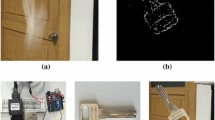Abstract
Background
High-speed strain field measurement based on digital image correlation (DIC) is limited by high equipment cost and large transmission bandwidth requirements for high-speed cameras. Emerging event-based cameras offer microsecond time resolution and low power consumption, generate events by asynchronously detecting illumination intensity changes at each pixel, have potential for applications in high-speed strain field measurements as a low-cost solution.
Objective
Using an event camera to directly capture a deformation process has some limitations, including motion blur, unclear images, and uneven gray scale quantization. This paper proposes a new method to avoid the above limitations.
Methods
A strobe light is used to assist image reconstruction for event cameras. Event cameras can generate events using a strobe light to illuminate the object with white speckle on black background, to obtain a speckle image at a specific moment, and then use DIC to obtain the displacement and strain fields.
Results
Validation experiments were performed, capturing 2D displacement and strain fields at 1000 frames per second with 1280 × 800 pixel resolution, and DIC matching error = 0.4 pixels.
Conclusions
This paper introduces a novel using strobe lighting to assist image reconstruction for event cameras. This technique presents a cost-effective alternative for high-speed deformation measurements, bypassing the constraints of directly capturing the deformation process with an event camera. The proposed method exhibits remarkable adaptability to the motion speed of the object being measured, while maintaining high temporal resolution and low data redundancy.













Similar content being viewed by others
Data Availability
Data underlying the results presented in this paper are not publicly available at this time but may be obtained from the authors upon reasonable request.
References
Su Z, Pan J, Zhang S, Wu S, Yu Q, Zhang D (2022) Characterizing dynamic deformation of marine propeller blades with stroboscopic stereo digital image correlation. Mech Syst Signal Process 162
Duan QY, Xue HW, Yang YH, Zhou YZ, Xie HM, He W (2022) Study on fracture behavior of nickel-based single crystal superalloy subjected to high temperature fatigue using digital image correlation. Int J Fatigue 155
Xue Y, Cheng T, Xu XH, Gao ZR, Li QQ, Liu XJ, Wang X, Song R, Ju XY, Zhang QC (2017) High-accuracy and real-time 3D positioning, tracking system for medical imaging applications based on 3D digital image correlation. Opt Lasers Eng 88:82–90
Xu XH, Su Y, Zhang QC (2017) Theoretical estimation of systematic errors in local deformation measurements using digital image correlation. Opt Lasers Eng 88:265–279
Peters WH, Ranson WF (1982) Digital imaging techniques in experimental stress-analysis. Opt Eng 21:427–431
Yamaguchi I (1981) A laser-speckle strain-gauge. J Phys E Sci Instruments 14:1270–1273
Su Z, Lu L, He X, Yang F, Zhang D (2020) Recursive-iterative digital image correlation based on salient features. Opt Eng 59:034111–034111
Tiwari V, Sutton MA, McNeill SR, Xu S, Deng X, Fourney WL, Bretall D (2009) Application of 3D image correlation for full-field transient plate deformation measurements during blast loading. Int J Impact Eng 36:862–874
Wang Y, Gao Z, Fang Z, Su Y, Zhang Q (2023) Rotating Vibration Measurement Using 3D Digital Image Correlation. Exp Mech 63:565–579
Wang C, Ma S, Liu G, Zhu H, Ma Q (2020) Correction of start-up time difference-induced measurement errors of a high-speed binocular stereovision system. Optic Lasers Eng 126
Gallego G, Delbruck T, Orchard GM, Bartolozzi C, Taba B, Censi A, Leutenegger S, Davison A, Conradt J, Daniilidis K, Scaramuzza D (2022) Event-Based Vision: A Survey. IEEE Trans Pattern Anal Mach Intell 44:154–180
Glover A, Bartolozzi C (2016) IEEE: Event-Driven Ball Detection and Gaze Fixation in Clutter, IEEE/RSJ International Conference on Intelligent Robots and Systems (IROS). Daejeon, South Korea pp 2203–2208
Zhu AZ, Yuan L, Chaney K, Daniilidis K (2018) EV-FlowNet: Self-Supervised Optical Flow Estimation for Event-based Cameras, 14th Conference on Robotics - Science and Systems. Carnegie Mellon Univ, Pittsburgh, PA
Paredes-Valles F, Scheper KYW, de Croon G (2020) Unsupervised Learning of a Hierarchical Spiking Neural Network for Optical Flow Estimation: From Events to Global Motion Perception. IEEE Trans Pattern Anal Mach Intell 42:2051–2064
Jiao J, Huang H, Li L, He Z, Zhu Y, Liu M, Soc IC (2021) Comparing Representations in Tracking for Event Camera-based SLAM, IEEE/CVF Conference on Computer Vision and Pattern Recognition (CVPR). Electr Netw pp 1369–1376
Huang X, Zhang Y, Xiong Z (2021) High-speed structured light based 3D scanning using an event camera. Opt Express 29:35864–35876
Rebecq H, Gallego G, Mueggler E, Scaramuzza D (2018) EMVS: Event-Based Multi-View Stereo3D Reconstruction with an Event Camera in Real-Time. Int J Comput Vision 126:1394–1414
Gao Z, Su Y, Zhang Q (2022) Single-event-camera-based 3D trajectory measurement method for high-speed moving targets. Chin Opt Lett 20:061101
Blaber J, Adair B, Antoniou A (2015) Ncorr: Open-Source 2D Digital Image Correlation Matlab Software. Exp Mech 55:1105–1122
Funding
This work was supported by the National Natural Science Foundation of China (grants 12232017, 11872354, 12102423) and the National Science and Technology Major Project (J2019-V-0006-0100).
Author information
Authors and Affiliations
Corresponding authors
Ethics declarations
Conflict of Interests
The authors declare that they have no known competing financial interests or personal relationships that could have appeared to influence the work reported in this paper.
Additional information
Publisher's Note
Springer Nature remains neutral with regard to jurisdictional claims in published maps and institutional affiliations.
Supplementary Information
Below is the link to the electronic supplementary material.
Supplementary file1 (AVI 2066 KB)
Supplementary file2 (AVI 2091 KB)
Supplementary file3 (AVI 236 KB)
Supplementary file4 (AVI 816 KB)
Supplementary file5 (AVI 808 KB)
Supplementary file6 (AVI 258 KB)
Rights and permissions
Springer Nature or its licensor (e.g. a society or other partner) holds exclusive rights to this article under a publishing agreement with the author(s) or other rightsholder(s); author self-archiving of the accepted manuscript version of this article is solely governed by the terms of such publishing agreement and applicable law.
About this article
Cite this article
Zhu, C., Gao, Z., Xue, W. et al. High-Speed Deformation Measurement with Event-Based Cameras. Exp Mech 63, 987–994 (2023). https://doi.org/10.1007/s11340-023-00966-7
Received:
Accepted:
Published:
Issue Date:
DOI: https://doi.org/10.1007/s11340-023-00966-7




